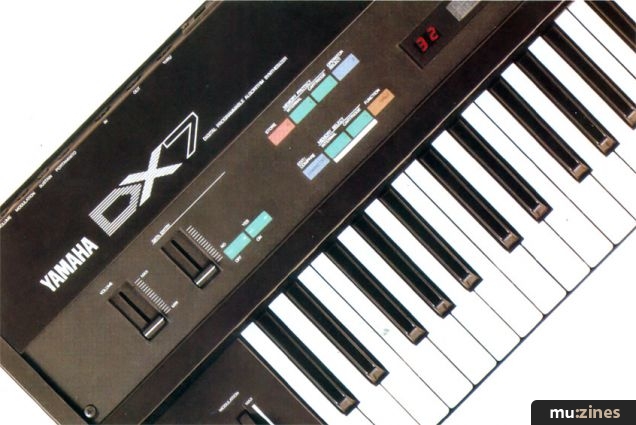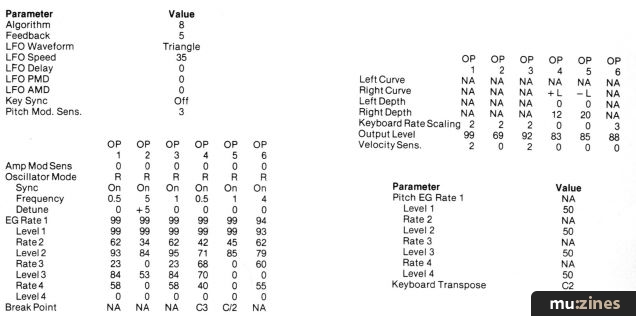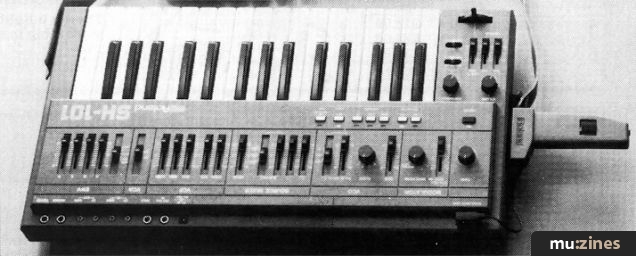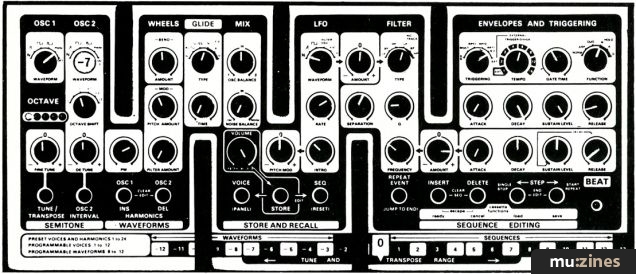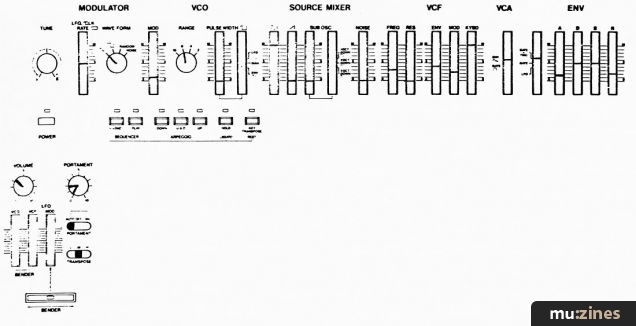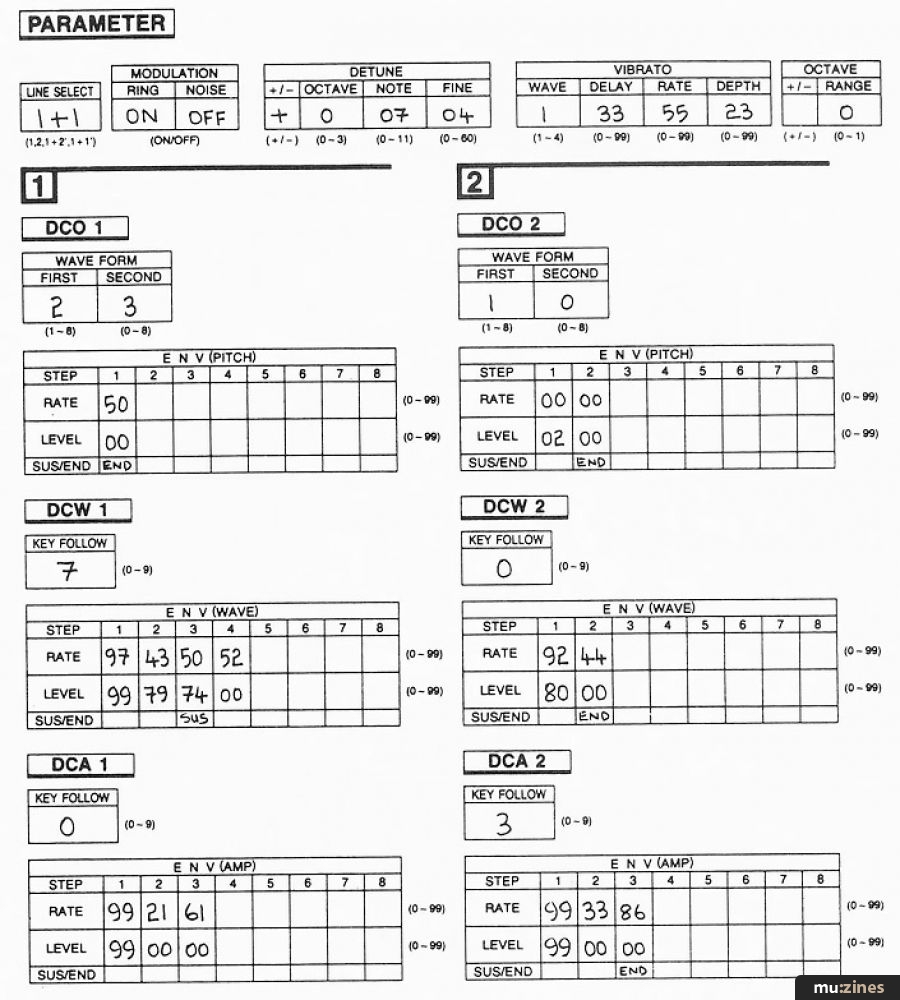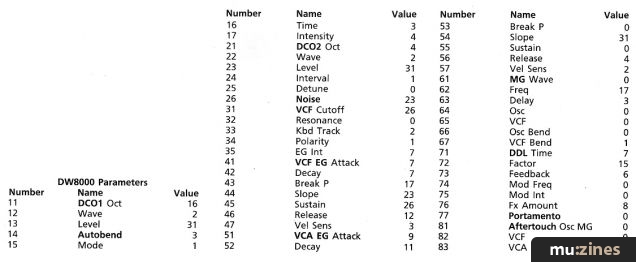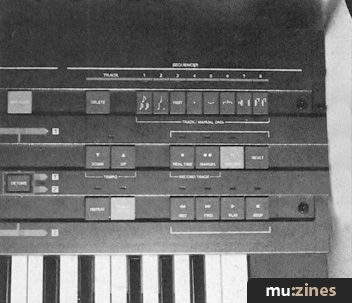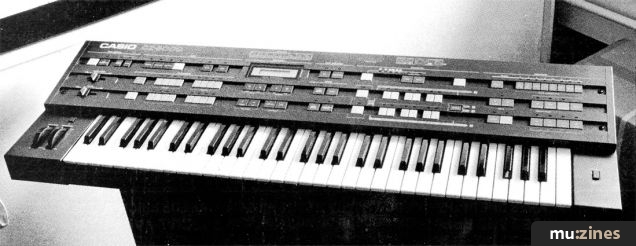Magazine Archive
Home -> Magazines -> Issues -> Articles in this issue -> View
Patchwork | |
Article from Music Technology, October 1987 | |
Yamaha's classic CS80 makes a welcome appearance alongside the CZ101, Bit 99 and DW6000, and more ROMs for the DX7 complete this month's selection of readers' sounds.
If you're still waiting to see your particular synth featured in these pages, then why not be the first to submit some sounds?
Don't forget that if your patch gets published, you'll receive a free year's subscription to MUSIC TECHNOLOGY with our compliments. So send us your favourite sounds on a photocopy of an owner's manual chart (coupled with a blank one for artwork purposes) accompanied by a short demo-tape (don't worry too much about classic performances and impeccable recording quality; just present your sounds simply and concisely - and convince us you're the best of the bunch). Include a decent-length description of your sound and its musical purpose in life, and write your full name and address on each chart. And remember, edited presets are all very well, but an original masterpiece is always preferable. OK?
The address to send sounds to: Patchwork, (Contact Details).
CASIO CZ101 - Snare With A Tail
Olli Kaarnisto, Finland
Seeing as this month's Sounds Natural is all about synthesising the snare drum, we felt Olli's set of percussion sounds had arrived at an opportune moment. This is our favourite from the range of bass, tom and snare sounds submitted - it's a punchy, fairly sharp snare that should blend well in any mix.

(Click image for higher resolution version)
Available files:
 Snare With A Tail.syx.zip (715 B)
Snare With A Tail.syx.zip (715 B)
Single patch for CZ series
ben@muzines | 6th Dec 2019 | Downloads: 102
Arturia CZ-V patch
ben@muzines | 6th Dec 2019 | Downloads: 88
Virtual CZ aupreset
ben@muzines | 6th Dec 2019 | Downloads: 83
Virtual CZ VST3 preset
ben@muzines | 6th Dec 2019 | Downloads: 86
BIT 99 - Bits 'n' Pieces
Nigel Craig, Bangor, NI

(Click image for higher resolution version)
A selection of sounds from Nigel for the Bit 99. Included are the parameter names, so Bit One owners should be able to adapt the sounds for their keyboards (it seems the only parameter that may differ in intensity is the LFO modulation, so set that one to taste). The sounds are briefly described as:
Juno Strings (A): an attempt to emulate a typical Roland Junos' string sound, but obviously without the chorus.
Bellow Church Organ (B): as named but without the pumping and squeaking.
Synth Chimes (C): a synthesised chime to imitate the chimes of old-fashioned clocks.
Psycho Synth Bell (D): a synth bell with a 'psycho' detuning ring.
YAMAHA CS80 - Classic CS
Tom Szakaly, Rochdale
Its nice to see a classic synth like the CS80 getting a look-in among the CZs and DXs... Tom describes his creation as "a general purpose sound particularly suited to 'fat', sustained-type backing; an overall 'wash' of sound with plenty of movement. Having said that, it works for lead lines as well, being equally effective on staccato arrangements (having the necessary 'bite' on the attack portion of the sound)." Who's next then? Minimoog anyone?

(Click image for higher resolution version)
KORG DW6000 - Five Go Down To Play
Daren Horley, Rainham, Kent

A selection of patches for Korg's popular DW6000, which we're sure DW8000 owners will be able to adapt and build on to their heart's content. Daren describes his sounds as:
1) A stringy sound with a "vocal" touch at the bass end. Enhanced by lashings of delay!
2) A rather digital dangerous sound. Good for chordal work.
3) A sound not a million miles away from a cello or violin quartet.
4) A haunting, distant whistle. Add delay to taste!
5) A harsh bass sound, flange as the mood takes you!

(Click image for higher resolution version)
RITTOR VOICE ROMS
For the Yamaha DX7

SYNTHESISER PROGRAMMERS MAY be a talented and dedicated bunch, but they do lack at least one important quality. Hardly any of them (Dave Bristow and Bo Tomlyn stand out as being exceptions) have the ability to catch the public's imagination as personalities. I mean, have you seen any synth programmers on television recently? Thought not.
Faced with this marketing problem, the Japanese have called on the services of three "big name" music-playing acts who also just happen to be decent DX7 programmers. The result is a set of three new ROM cartridges of 64 sounds each, programmed by Toto's David Paich and Steve Porcaro, Minoru Mukaiya of Casiopea, and Ryuichi Sakamoto.
Toto first. The sounds are arranged in the time-honoured DX7 fashion of two banks of 32 (remember we're talking the Mk1 instrument here) and are roughly arranged in "families": brass, wind and tuned percussion on bank A, pianos, effects and combination sounds on bank B.
Like the earlier Shofuku cartridges (see MT September '86), all these come with notes on each sound, this time penned by the artists themselves. However, the Toto notes are derived from a brief conversation with the two men in an airport departure lounge, and aren't too useful. Paich describes one sound as "a different kind of wind pad", and Porcaro offers us such gems of wisdom as "a bass sound Dave likes to use a lot" and "my first solo attempt at a Hammond sound".
Patchy documentation aside, however, the Toto collection is quite a strong one. For although the "crystal clear" sounds like marimbas, strings and harps have all been heard before, there are some excellent - and distinctive - variations on familiar themes.
Xylospiel 2, for example, is a clever combination sound with a "wooden" attack that becomes more metallic with greater velocity; 99 Voices is a beefier-than-average FM choir sound; and Toto Wurly is the finest approximation of a Wurlitzer sound this writer has heard a synth produce - a refreshing change after hearing so many feeble attempts at a Rhodes.
Casiopea are, in case you were wondering, a successful Japanese band in the Shakatak mould (though they're a bit more experimental), and are the closest Yamaha have to a "house band" in their native country.
It's not surprising, then, to see the band's keyboard player wax lyrical about the DX7 in his ROM notes - though these are, fortunately, a bit more enlightening than Toto's.
In essence, the Mukaiya ROM represents an attempt (not the first, it's true) at coaxing chunkier, more rough-sounding textures out of the DX. And to a large extent, it succeeds. There are some fine detuned vibes, marimbas and celestes (in contrast with Toto's pedestrian efforts in this area), and some distinctive strings programs that benefit from judicious use of the DX7's Pitch EG.
On the other hand, many of these voices sound as if they've had the sparkle taken from them in an effort to improve their chances of surviving a complicated mix. And as such, they've lost some of their character, with the pianos, human voices and brass all sounding powerful but, in the final analysis, bland.
If ever there was a collection of sounds that gave the impression of being half-finished, the Mukaiya cartridge is it. Then again, if you're keen on tweaking your ROM sounds to suit your own taste, that may be a good thing.
Finally, Ryuichi Sakamoto's work as composer, musician, producer and programmer needs no introduction from me. His two banks of sounds divide neatly into those suited to live use (complete with wide dynamic range, liberal use of performance controls to alter timbre, and so on) and those aimed primarily at recording (where sounds are more even).
This in itself is extremely laudable: too many synth sounds (and not just FM ones) lend themselves to live performance, but play havoc with the levels once you're off the stage and into the studio. And Sakamoto's notes are the best of this bunch, scoring points not just for giving details of where the composer has used his sounds, but also for offering suggestions as to how they can be altered by the user.
Generally speaking, both sets have an "analogue" feel to them - though they're a good bit cleaner than Mukaiya's. Almost all the "live" sounds which Sakamoto actually calls Analog are interesting - rich, vibrant lead sounds that conjure up audible images of Moog or Oberheim without ever seeming to be imitations of those instruments.
There are also some silky, atmospheric strings on the "live" side, though these do suffer quite noticeably from having their dynamics muted on bank B.
Still, the "recording" side does feature some fascinating special effects. Ondmartin, for instance, must be the world's first FM simulation of that ancient electronic instrument, the Ondes Martenot; it's uncannily accurate, even if the programming can't have been too taxing.
Best of all are Waao Voice and Environment: two shimmering, unpredictable (and usable) patches that sound as though they're derived from acoustic timbres, yet somehow couldn't have been created with anything that didn't have "DX" written on it.
It's a pity that there isn't more of the wackier side of Sakamoto's programming on this ROM. Some of the more conventional sounds are all very well, but I'm not sure they're what musicians would actually buy a Ryuichi ROM for.
If these three ROMs teach us anything, it's that many of the sounds top programmers use on their records really aren't all that special. In reality, the sounds themselves are only as good as the way they're played, how well they're integrated into an arrangement, and (especially in 1987) how they're processed in the studio.
If your playing, your arranging and your processing are up to scratch, there's some thought-provoking stuff on all three of these "big name artist" cartridges. But there are no instant miracles.
Price £49.95 including VAT
More from Rittor Music Europe, (Contact Details)
More with this topic
Patches |
Patchwork |
Patchwork |
Patchwork |
Patchwork |
Patchwork |
Patchwork |
Patchwork |
Program Notes - The Return Of... |
Patchwork |
Patchwork |
Patchwork |
Browse by Topic:
Synthesizer Patches
Also featuring gear in this article
A Bit On The Side - Bit 99 Polysynth
(EMM Oct 85)
BeeBMIDI (Part 3)
(EMM Aug 84)
BeeBMIDI (Part 7)
(EMM Mar 85)
Bit 99 - Synthcheck
(IM Oct 85)
Bit 99 Synth
(12T Nov 85)
Casio CZ-101 - Professional Polyphonic Synth
(IT Jan 85)
Casio CZ101
(12T Jan 85)
Casio CZ101 - Synthcheck
(IM Feb 85)
Digital Dynamite
(ES Jan 85)
Hands On: Yamaha DX7
(SOS Dec 92)
Korg DW-6000
(12T Apr 85)
Korg DW6000 - Synthcheck
(IM Apr 85)
Load Baring
(12T May 85)
Load Baring
(12T Aug 85)
Making Waves - DW-6000
(ES Apr 85)
Patchwork
(EMM Feb 84)
Patchwork
(EMM Mar 84)
Patchwork
(EMM Apr 84)
Patchwork
(EMM May 84)
Patchwork
(EMM Jul 84)
Patchwork
(EMM Aug 84)
Patchwork
(EMM Jan 85)
Patchwork
(EMM Feb 85)
Patchwork
(EMM Apr 85)
Patchwork
(EMM Jun 85)
Patchwork
(EMM Jul 85)
Patchwork
(EMM Feb 86)
Patchwork
(EMM Mar 86)
Patchwork
(EMM Apr 86)
Patchwork
(EMM May 86)
Patchwork
(EMM Jun 86)
Patchwork
(EMM Aug 86)
Patchwork
(EMM Sep 86)
Patchwork
(EMM Oct 86)
Patchwork
(MT Nov 86)
...and 19 more Patchwork articles... (Show these)
Browse category: Synthesizer > Casio
Browse category: Synthesizer > Crumar
Browse category: Synthesizer > Korg
Browse category: Synthesizer > Yamaha
Featuring related gear
A Sound Design - Design Studio Programs
(ES Jan 85)
Back to Back
(EMM Nov 85)

Back to Back
(IM Dec 85)
Bit One - Synthcheck
(IM Jan 85)
Casio CZ 5000
(12T Jul 85)
Casio CZ-230S - SynthCheck
(IM Jul 86)
Casio CZ-5000 - Synthcheck
(IM Aug 85)
Casio CZ230S Keyboard
(EMM May 86)
Casio CZ3000 - The Obvious Solution?
(SOS Apr 86)
Casio CZ3000 Polysynth
(EMM Feb 86)
Casio CZ3000 Synth
(12T Apr 86)
Chase Bit One - Programmable Polysynth
(EMM Nov 84)
Crumar Bit One
(12T Dec 84)
CZ Top - Casio CZ5000
(ES Jul 85)
Delirious Xcitement - Yamaha DX7S
(SOS Mar 88)
Double Take - Yamaha DX5
(ES Apr 85)
Expand Ability
(EMM Jul 85)
Expand your DX
(SOS Jan 87)
Patchwork
(EMM May 86)
Patchwork
(EMM Aug 86)
Patchwork
(EMM Sep 86)
Patchwork
(EMM Oct 86)
Patchwork
(MT Nov 86)
Patchwork
(MT Dec 86)
Patchwork
(MT Feb 87)
Patchwork
(MT Mar 87)
Patchwork
(MT May 87)
Patchwork
(MT Aug 87)
Patchwork
(MT Feb 88)
Patchwork
(MT Aug 88)
Patchwork
(MT Dec 88)
Patchwork
(MT May 89)
Patchwork
(MT Sep 89)
Patchwork
(MT Nov 89)
...and 15 more Patchwork articles... (Show these)
Program Notes
(MM Sep 86)
Program Notes
(MM Nov 87)
Browse category: Software: Editor/Librarian > Sound Design Studio
Browse category: Synthesizer > Korg
Browse category: Synthesizer > Crumar
Browse category: Synthesizer > Casio
Browse category: Synthesizer > Yamaha
Browse category: Synthesizer Module > Crumar
Browse category: Expansion Board > Grey Matter Response
Publisher: Music Technology - Music Maker Publications (UK), Future Publishing.
The current copyright owner/s of this content may differ from the originally published copyright notice.
More details on copyright ownership...
Article has file downloads
Topic:
Synthesizer Patches
Gear in this article:
Synthesizer > Casio > CZ-101
Synthesizer > Crumar > Bit 99
Synthesizer > Korg > DW-6000
Synthesizer > Yamaha > DX7
Gear Tags:
Digital Synth
Analog Synth
FM Synth
FM 6-Operator
Analog/Digital Hybrid Synth
Phase Distortion
Polysynth
Feature by Dan Goldstein
Previous article in this issue:
Help Support The Things You Love
mu:zines is the result of thousands of hours of effort, and will require many thousands more going forward to reach our goals of getting all this content online.
If you value this resource, you can support this project - it really helps!
Donations for September 2025
Issues donated this month: 0
New issues that have been donated or scanned for us this month.
Funds donated this month: £0.00
All donations and support are gratefully appreciated - thank you.
Magazines Needed - Can You Help?
Do you have any of these magazine issues?
If so, and you can donate, lend or scan them to help complete our archive, please get in touch via the Contribute page - thanks!







 Upload an audio preview and/or patch preset file for this patch
Upload an audio preview and/or patch preset file for this patch
























